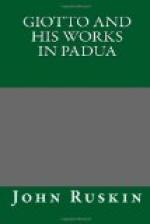“Noting the visages
of some who lay
Beneath the pelting of that
dolorous fire,
One of them all I knew not;
but perceived
That pendent from his neck
each bore a pouch,
With colours and with emblems
various marked,
On which it seemed as if their
eye did feed.
And when amongst them looking
round I came,
A yellow purse I saw, with
azure wrought,
That wore a lion’s countenance
and port.
Then, still my sight pursuing
its career,
Another I beheld, than blood
more red,
A goose display of whiter
wing than curd.
And one who bore a fat
and azure swine
Pictured on his white scrip,
addressed me thus:
What dost thou in this deep?
Go now and know,
Since yet thou livest, that
my neighbour here,
Vitaliano, on my left shall
sit.
A Paduan with these Florentines
am I.
Ofttimes they thunder in mine
ears, exclaiming,
Oh! haste that noble knight,
he who the pouch
With the three goats will
bring. This said, he writhed
The mouth, and lolled the
tongue out, like an ox
That licks his nostrils.”
Canto xvii.
This passage of Cary’s Dante is not quite so clear as that translator’s work usually is. “One of them all I knew not” is an awkward periphrasis for “I knew none of them.” Dante’s indignant expression of the effect of avarice in withering away distinctions of character, and the prophecy of Scrovegno, that his neighbor Vitaliano, then living, should soon be with him, to sit on his left hand, is rendered a little obscure by the transposition of the word “here.” Cary has also been afraid of the excessive homeliness of Dante’s imagery; “whiter wing than curd” being in the original “whiter than butter.” The attachment of the purse to the neck, as a badge of shame, in the Inferno, is found before Dante’s time; as, for instance, in the windows of Bourges cathedral (see Plate iii. of mm. Martin and Cahier’s beautiful work). And the building of the Arena Chapel by the son, as a kind of atonement for the avarice of the father, is very characteristic of the period, in which the use of money for the building of churches was considered just as meritorious as its unjust accumulation was criminal. I have seen, in a Ms. Church-service of the thirteenth century, an illumination representing Church-Consecration, illustrating the words, “Fundata est domus Domini supra verticem montium,” surrounded for the purpose of contrast, by a grotesque, consisting of a picture of a miser’s death-bed, a demon drawing his soul out of his mouth, while his attendants are searching in his chests for his treasures.]




